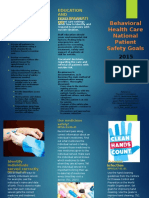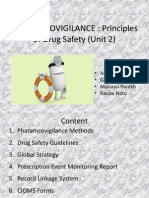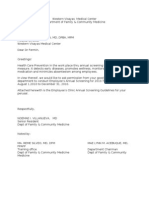Poster For National Patient Safety GOALS 2013 IEC Material
Poster For National Patient Safety GOALS 2013 IEC Material
Uploaded by
silveoCopyright:
Available Formats
Poster For National Patient Safety GOALS 2013 IEC Material
Poster For National Patient Safety GOALS 2013 IEC Material
Uploaded by
silveoOriginal Description:
Original Title
Copyright
Available Formats
Share this document
Did you find this document useful?
Is this content inappropriate?
Copyright:
Available Formats
Poster For National Patient Safety GOALS 2013 IEC Material
Poster For National Patient Safety GOALS 2013 IEC Material
Uploaded by
silveoCopyright:
Available Formats
National Patient Safety GOALS 2013
Goal 1 Improve the Accuracy of Patient Identification
Use at least two patient identifiers: patients full name and date of birth (not to be the patients room number) when administering medications or blood products; taking blood samples and other specimens for clinical testing, or providing any other treatments or procedures. Eliminate transfusion errors related to patient misidentification
Goal 15 The Organization Identifies Safety Risks Inherent in its Patient Population. (Suicidal Ideation)
Goal 2 Improve the Effectiveness of Communication Among Caregivers.
Report critical results of tests and diagnostic procedures to the appropriate staff on time.
Critical results of tests and diagnostic procedures fall significantly outside the normal range and may indicate life threatening situation. The objective Report critical results of tests andadiagnostic procedures on a timely is to provide the responsible licensed caregiver these results within an basis. established time frame so that the patient can be promptly treated.
The organization identifies patients at risk for suicide. Applicable to psychiatric hospitals and patients being treated for emotional or behavioral disorders in general hospitals. Find out which patients are most likely to try to commit suicide through a screening process during admission and thereafter.
Universal Protocol T h (UP 1) e
o r g a n i z a t i o The Universal Protocol (UP1) explains how to n prevent a procedure on a wrong patient, wrong side
Goal 3
Improve the Safety of Using Medications.
Label all medications, medication containers (e.g., syringes, medicine cups, basins), or other solutions on and off the sterile field in perioperative and other procedural settings.
Reduce the likelihood of patient harm associated with the use of Anticoagulation therapy. Take extra care with the patient who takes the medicine to thin their blood.
Maintain and communicate accurate patient medication Information through the Medication Reconciliation process. Record and pass along correct information about a patients medicines. Find out what medicines the patient is taking. Compare those medications to new medication given to the patient. Make sure the patient knows which medicines to take when they are at home. Tell the patient it is important to bring their up-to-date list of medications every time they visit a doctor or a health care provider.
and wrong site. It ensures that the correct surgery is s done on the correct patient and at the correct site on e the patients body. l e Conduct a pre-procedure verification process as c stated in the Universal Protocol (UP1). t s Mark the correct site on the patients body where the surgery is to be a performed. Pause and Conduct a time-out immediately before s starting the procedure as described in the UP1. u i t a b l e
Goal 7 Reduce the Risk of Health Care-associated We comply with current Centers for Disease Control Infections.
and Prevention (CDC) hand hygiene guidelines. Implement evidence-based practices to prevent health care-associated infections due to 1. Multi Drug Resistant Organisms, 2. Central Line Associated Bloodstream Infections 3. Surgical Site Infections. 4. Catheter Associated Urinary Tract Infections.
Prepared by The Department of Patient m Safety
e
Phone: (718) 270-8165 t Edited on: 01/2013
h o d t
Fax: (718) 613-8755
You might also like
- Interview Questions-PVDocument9 pagesInterview Questions-PVtausif50% (2)
- AHM 540 - TestsDocument67 pagesAHM 540 - Testspraveen1510No ratings yet
- TPA Grade SheetDocument3 pagesTPA Grade SheetAndrew MillerNo ratings yet
- MedicationsDocument13 pagesMedicationsReynaKatNo ratings yet
- Practices of IV Therapy: Chapter OutlineDocument20 pagesPractices of IV Therapy: Chapter OutlineDannah Jean GranNo ratings yet
- National Patient Safety GoalsDocument7 pagesNational Patient Safety GoalsyaniNo ratings yet
- Behavioral Health Care National Patient Safety Goals: Education AND Documentati ONDocument2 pagesBehavioral Health Care National Patient Safety Goals: Education AND Documentati ONMissy Wyckoff HartNo ratings yet
- 2012 NPSG HapDocument1 page2012 NPSG HapDwiyanti WNo ratings yet
- Pharmacovigilance-Glossary FIFARMA ENDocument10 pagesPharmacovigilance-Glossary FIFARMA ENvikashchaturvedi618No ratings yet
- International Patient Safety GoalsDocument30 pagesInternational Patient Safety GoalsMuvenn Kannan50% (2)
- Principles of EpidemiologyDocument5 pagesPrinciples of EpidemiologyJaffar ZabertNo ratings yet
- NPSG 2015Document1 pageNPSG 2015Dwi SurantoNo ratings yet
- Patient SafetyDocument3 pagesPatient SafetyHoney RojanneNo ratings yet
- Principles of EpidemiologyDocument10 pagesPrinciples of EpidemiologyDEREK DARRELNo ratings yet
- PT SafetyDocument9 pagesPT Safetyabaidurrehman0546No ratings yet
- Jcinabhqualityimprovementproposal1 150301235729 Conversion Gate02Document31 pagesJcinabhqualityimprovementproposal1 150301235729 Conversion Gate02Abhishek TrivediNo ratings yet
- Guillain Barre SyndromeDocument21 pagesGuillain Barre Syndromebasinang_jangilNo ratings yet
- Notes To PharmacovigilanceDocument58 pagesNotes To Pharmacovigilancejay100% (1)
- IntroductionDocument22 pagesIntroductionsaurabh dhyaniNo ratings yet
- Ipsg # 2017 PDFDocument30 pagesIpsg # 2017 PDFDARRYLARANHA100% (1)
- Table 1.1. Guidelines and Implementation Tips For Pharmacy-Based Immunization Advocacy and DeliveryDocument5 pagesTable 1.1. Guidelines and Implementation Tips For Pharmacy-Based Immunization Advocacy and DeliveryMarryNo ratings yet
- Med 1Document1 pageMed 1Roy Vincent OtienoNo ratings yet
- IPSGDocument4 pagesIPSGmohsinaNo ratings yet
- Rational Drug Use: Zikria, PH.DDocument47 pagesRational Drug Use: Zikria, PH.DKiran ZahraNo ratings yet
- Bentuk-Bentuk NegaraDocument48 pagesBentuk-Bentuk NegaraMas Yudha WaeNo ratings yet
- JCI Newsletter May 8 IPSGDocument6 pagesJCI Newsletter May 8 IPSGAhmad HaririNo ratings yet
- IPSG GoalslDocument10 pagesIPSG GoalsljebashanthiniNo ratings yet
- Home Health National Patient Safety GoalsDocument3 pagesHome Health National Patient Safety Goalsjenn1722No ratings yet
- Pharmacology Kylie ThomasDocument17 pagesPharmacology Kylie ThomasRebekah RobertsNo ratings yet
- Situational Analysis - EthicsDocument2 pagesSituational Analysis - EthicsDeejune TorrinoNo ratings yet
- IPSGDocument4 pagesIPSGmohsinaNo ratings yet
- Patient Safety: An Introduction: Jhessie L. Abella, RN, RM, MAN, CpsoDocument22 pagesPatient Safety: An Introduction: Jhessie L. Abella, RN, RM, MAN, Cpsoprinsepejesse100% (1)
- Experiment10 Adverse Drug Reaction MonitoringDocument3 pagesExperiment10 Adverse Drug Reaction MonitoringGelieNo ratings yet
- Diagnosis and Management of Community-Acquired Pneumonia: Evidence-Based PracticeDocument11 pagesDiagnosis and Management of Community-Acquired Pneumonia: Evidence-Based PracticeMega Julia ThioNo ratings yet
- Personalised MedicineDocument25 pagesPersonalised MedicineRevanti MukherjeeNo ratings yet
- Pprev Med 1Document3 pagesPprev Med 1Naomi NicoleNo ratings yet
- Case Scenario Evidence Based PracticeDocument3 pagesCase Scenario Evidence Based PracticeAdrienne Nicole PaneloNo ratings yet
- PV Assignment 2Document5 pagesPV Assignment 2bhavishyaroll.4sec.aNo ratings yet
- Farmacovigilancia RevisionDocument16 pagesFarmacovigilancia RevisionOfelia RomeroNo ratings yet
- Outbreak TranscriptDocument21 pagesOutbreak TranscriptlilkaskitcNo ratings yet
- Aetcom Module - 2Document3 pagesAetcom Module - 2Aishwarya NayakaNo ratings yet
- IPSGDocument16 pagesIPSGNyimas Milka Ayu NabilaNo ratings yet
- KeywordsDocument12 pagesKeywordsaadrika negiNo ratings yet
- Introduction Scope Objective Requirements For Icsrs 15 Days Alert Report Source of Icsr Reporting Procedure Conclusion ReferenceDocument10 pagesIntroduction Scope Objective Requirements For Icsrs 15 Days Alert Report Source of Icsr Reporting Procedure Conclusion Referenceaadrika negiNo ratings yet
- International Standard For Tuberculosis Care 2009Document5 pagesInternational Standard For Tuberculosis Care 2009Stephanie DewiNo ratings yet
- Pharmaco VigilanceDocument15 pagesPharmaco Vigilancekazi lemonNo ratings yet
- Healthcare SafetyDocument3 pagesHealthcare SafetySanjeeb KakatiNo ratings yet
- Overview of the Indian Diagnostic IndustryDocument39 pagesOverview of the Indian Diagnostic IndustryManav NandaNo ratings yet
- Search BMJ GroupDocument23 pagesSearch BMJ GroupCharles BrooksNo ratings yet
- PV NoteDocument36 pagesPV Notepaul DebasishNo ratings yet
- Dr. MagedDocument7 pagesDr. MagedmagedNo ratings yet
- Practices: in Patient CareDocument5 pagesPractices: in Patient Careahmad nuril hidayatNo ratings yet
- Pharmacovigilance DefinationsDocument32 pagesPharmacovigilance DefinationsKadir AmirNo ratings yet
- Pharmaco VigilanceDocument31 pagesPharmaco VigilanceRasika NatuNo ratings yet
- Safety Monitoring in Clinical TrailDocument3 pagesSafety Monitoring in Clinical TrailShivananda PradhanNo ratings yet
- NCM 119 Module Safety Part 2 Standards Lesson Safety National Quality Forum 2009Document59 pagesNCM 119 Module Safety Part 2 Standards Lesson Safety National Quality Forum 2009Maria Victoria A. PraxidesNo ratings yet
- 1090 Med Admin NotesDocument9 pages1090 Med Admin Notesasadwal416No ratings yet
- Chapter 13 NotesDocument3 pagesChapter 13 NotesRPh Krishna Chandra JagritNo ratings yet
- Pharmaceutical CareDocument22 pagesPharmaceutical CarefikebatuNo ratings yet
- Key Aspects of Rational Drug UseDocument13 pagesKey Aspects of Rational Drug UseUsama ArianNo ratings yet
- Guide To Infection Prevention For Outpatient Settings:: Minimum Expectations For Safe CareDocument42 pagesGuide To Infection Prevention For Outpatient Settings:: Minimum Expectations For Safe Caresalcais9042No ratings yet
- CertainlyDocument6 pagesCertainlyanjusonwani70No ratings yet
- Rabies - WHODocument43 pagesRabies - WHOsilveoNo ratings yet
- Breast Cancer ProtocolDocument24 pagesBreast Cancer Protocolsilveo100% (1)
- Western Visayas Medical Center Hospital As Center For Wellness Program Animal Bite CenterDocument2 pagesWestern Visayas Medical Center Hospital As Center For Wellness Program Animal Bite CentersilveoNo ratings yet
- ABC ProposalDocument4 pagesABC ProposalsilveoNo ratings yet
- World Health Organization: WHO/EMC/ZOO/96.6Document25 pagesWorld Health Organization: WHO/EMC/ZOO/96.6silveoNo ratings yet
- Annual Screening 2010Document3 pagesAnnual Screening 2010silveoNo ratings yet
- Animal Bite Accomlplishment Report 2011Document3 pagesAnimal Bite Accomlplishment Report 2011silveoNo ratings yet
- Module 6Document22 pagesModule 6Jhoanna Lovely OntulanNo ratings yet
- Chapter 14 Psychoneuroimmunology and Immune-Related Disorders - PublicDocument54 pagesChapter 14 Psychoneuroimmunology and Immune-Related Disorders - PublicShenNo ratings yet
- Guidelines For Clinical Management of Subcutaneous Dirofilariosis in Dogs and CatsDocument3 pagesGuidelines For Clinical Management of Subcutaneous Dirofilariosis in Dogs and CatsdmantsioNo ratings yet
- Urinary Tract Infection (UTI) in Males: Signs and SymptomsDocument33 pagesUrinary Tract Infection (UTI) in Males: Signs and Symptomssyak turNo ratings yet
- EN QuantiFast Probe RT PCR HandbookDocument52 pagesEN QuantiFast Probe RT PCR HandbookLidwinaNastassyaNo ratings yet
- Pelvic Inflammatory DiseaseDocument71 pagesPelvic Inflammatory DiseaseGraceline Margaretha Marsintauly SianiparNo ratings yet
- Swine FluDocument38 pagesSwine Fluapi-26012856No ratings yet
- OBGYN0622 Core GynecologyDocument4 pagesOBGYN0622 Core GynecologyAlex Bernales MartínezNo ratings yet
- REFLECTIONDocument3 pagesREFLECTIONAllyssa HeartNo ratings yet
- Alex Class 4Document8 pagesAlex Class 4Gustavo IannaconeNo ratings yet
- Pancretic Cancer Case Study - BurkeDocument52 pagesPancretic Cancer Case Study - Burkeapi-282999254No ratings yet
- 3011-Article Text-11322-2-10-20221109Document12 pages3011-Article Text-11322-2-10-20221109HidayahNo ratings yet
- MBBS Question BankDocument17 pagesMBBS Question Bankashawjanya26No ratings yet
- JJM Medical College Davangere Admission - Fee - Seats - ExamDocument10 pagesJJM Medical College Davangere Admission - Fee - Seats - ExamRakeshKumar1987No ratings yet
- E Portfolio Contemporary Nursing PresentationDocument6 pagesE Portfolio Contemporary Nursing Presentationapi-663116972No ratings yet
- Breast Reconstruction - Current TechniquesDocument288 pagesBreast Reconstruction - Current Techniquesamirekhalili1100% (2)
- Principles of Disease Control and PreventionDocument13 pagesPrinciples of Disease Control and PreventionAYO NELSON0% (1)
- Announcement Ina Sleep 2meiDocument10 pagesAnnouncement Ina Sleep 2meidiana rdNo ratings yet
- Lenvima Kapsul 4 MG - Lenvatinib - DKI1747700101A1 - 2020Document39 pagesLenvima Kapsul 4 MG - Lenvatinib - DKI1747700101A1 - 2020Efi OctavianyNo ratings yet
- Endoscopic Third VentriculostomyDocument58 pagesEndoscopic Third VentriculostomyBedussa NuritNo ratings yet
- Group 2 Nursing DiagnosisDocument68 pagesGroup 2 Nursing DiagnosisEmerald IsleNo ratings yet
- Image Diagnosis: Hemorrhagic Bullae in A Primary Varicella Zoster Virus InfectionDocument2 pagesImage Diagnosis: Hemorrhagic Bullae in A Primary Varicella Zoster Virus InfectionHaniNo ratings yet
- Aloe Vera Juice Side EffectsDocument2 pagesAloe Vera Juice Side EffectsSumit SharmaNo ratings yet
- Dialog Bhs Ing Priska AkwilaDocument3 pagesDialog Bhs Ing Priska AkwilaPriskaNo ratings yet
- Nutrition: Adam F. Feyaerts PH.D., Walter Luyten PH.D., M.DDocument4 pagesNutrition: Adam F. Feyaerts PH.D., Walter Luyten PH.D., M.DVania ZahraNo ratings yet
- Pencegahan HivDocument36 pagesPencegahan HivyaneemayNo ratings yet
- Endocervical Polyps in High Risk Human Papillomavirus InfectionsDocument4 pagesEndocervical Polyps in High Risk Human Papillomavirus InfectionsGLAYZA CLARITONo ratings yet
































































































